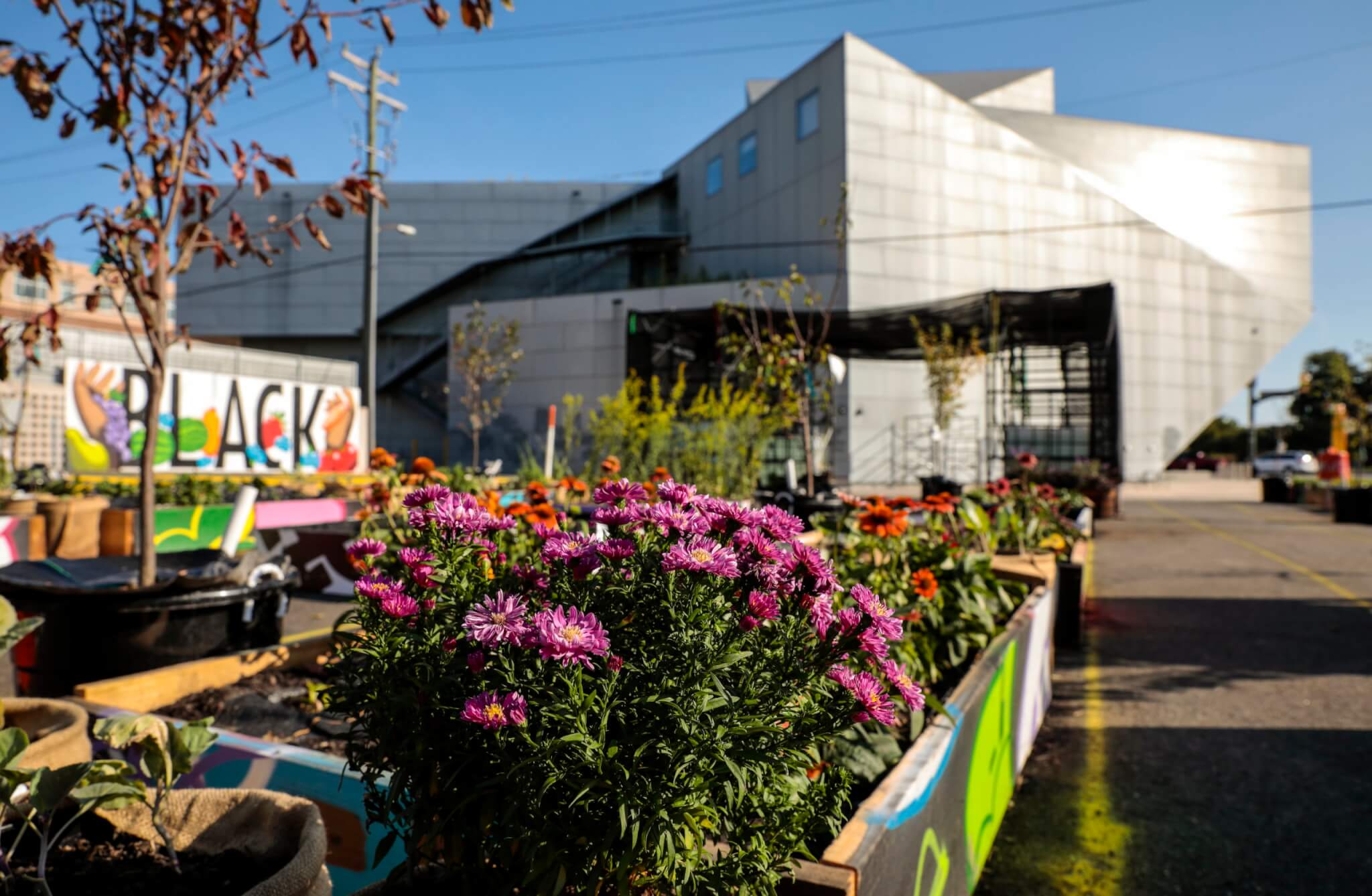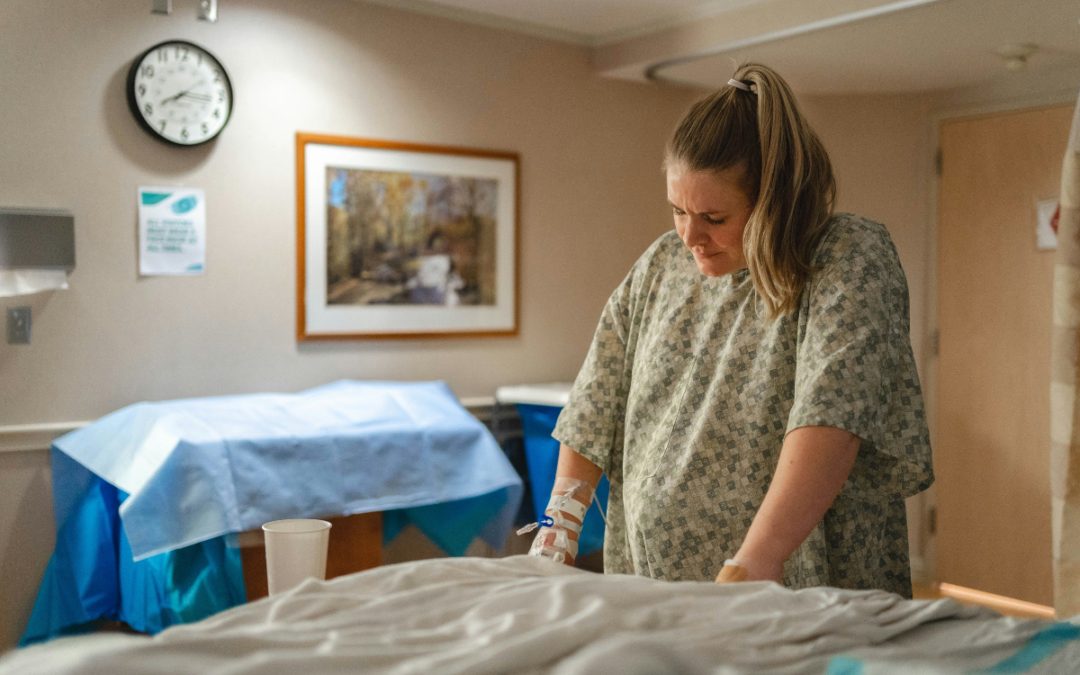
A look at "Commonwealth" at the Institute for Contemporary Art at Virginia Commonwealth University.
Lot behind Virginia Commonwealth University becomes one part art installation, one part community garden.
RICHMOND-For those travelling along Belvidere Street, you may have noticed a new sight recently. Popping out of the drab urban landscape, an abundant garden planted in brightly painted raised-beds and pots appeared in the vacant lot next to Virginia Commonwealth University’s Institute for Contemporary Art (ICA).
On first glance, it might look like any other community garden found throughout the city. However, there’s signs that the garden symbolizes much more. The message “BLACK SPACE MATTERS” is most notable, painted boldly on the pavement. This is an echo of the street murals that appeared in cities across the U.S. during the George Floyd protests earlier this summer.
More than just a community garden, “Resiliency Garden” is an art installation conceived by food activist Duron Chavist and designed by Quilian Riano of DSGN AGNC. It is part of ICA’s “Commonwealth” art exhibition, and represents the inequality of food access and accessible gathering spaces for Black communities.
Trying to define a Commonwealth
“Commonwealth” is an artistic and philosophical exercise attempting to explore the various ways the word resonates with communities that live in commonwealths. ICA presented the exhibit in collaboration with the Philadelphia Contemporary in Pennsylvania and Beta-Local in San Juan, Puerto Rico. Initially, all three locations were going to house the exhibit, but COVID-19 shut that down.
Each organization is based in a commonwealth. That commonality is what sparked the discussion of what that meant where they lived. For ICA and the Philadelphia Contemporary, that meant looking at the histories of Virginia and Pennsylvania. When the two colonies broke from British rule, who actually gained freedom?
“We were interested in thinking about how we became a commonwealth and what are its possibilities,” said Noah Simblist, chair of VCU’s Painting + Printing department and co-curator of the exhibit. “We were asking this question of who was “we” in “We the People” that was coming together for this common good. And, as we know, that didn’t include most people outside of land-owning white men.”

Negative connections
Similarly, Simblist said they were also thinking about Puerto Rico’s status as a commonwealth. He considered how many Puerto Ricans view the term negatively because of their limited rights as an unincorporated U.S. territory.
“For the fact for Puerto Ricans that commonwealth is the term that describes those limited rights, it means that it signals the reverse of coming together for the common good,” Simblist said. “Those are the tensions, contradictions and historical contexts we were thinking about.”
Commissioned artists developed artworks designed to comment on what commonwealth meant to them. Such works include an architectural piece and accompanying video performance commentating on colonial control by indigenous artist Tanya Lukin Linklater, a video documentary about American women’s football teams and how casual conversations become political by Sharon Hayes and a filmed dance performance choreographed by local Richmond artist Alicia Díaz that represents the connection of colonizing economies based on tobacco in Puerto Rico and Richmond and how that economy impacted women workers of color.
Fighting unequal access
Duron Chavis and Quilian Riano were two of the artists that were also selected by the organizers to participate in the Commonwealth exhibit. They had worked separately with the ICA before, and crossed paths at ICA’s Summer Sessions event last year.
“We partnered up with Quilian Riano and came up with the framework and design for the space and we went about the work of putting in the infrastructure to demonstrate how food justice intersects with racial justice and climate justice,” Chavis said. “While we are having these conversations, we wanted to reflect on the uprisings that have been happening so we thought of the idea “Black Space Matters” which is really reflective of the need of communities of color to have space to address issues and be solutionary in making spaces accessible for interventions to happen that can address inequities we see in our community.”
Duron Chavis has a long history of activism in Richmond, working as a community activist since he was 21. In 2003, Chavis was working for the Black History Museum and Cultural Center of Virginia when he founded Happily Natural Day, a festival that promotes wellbeing and cultural awareness.
It was at that festival in 2008 that he first began communicating with local Black farmers. They told him about the food accessibility issues Black communities in Richmond faced, including difficulties in finding affordable healthy food. According to nonprofit Feeding America, the food insecurity rate in Richmond is 20% for children alone.
Chavis began to collaborate with the farmers on initiatives such as modifying Community Shared Agriculture (CSAs) and starting pop-up farmers markets. Eventually this grew into building community gardens like McDonough Community Garden in Forest Hill.
Since the COVID-19 pandemic started, Chavis has redoubled his efforts on bringing food access to communities in need and helping community members grow food in their own backyards.
“We were getting ready to launch a class on community transformation of green space,” Chavis said. “Because of COVID, we couldn’t do that. Instead, we decided to give away raised beds to folks in the community. From late April to August we’ve delivered about 300 raised beds across the city.”
While Chavis worked on his his raised beds drive, “Commonwealth” exhibit organizers invited him to develop “Resiliency Garden” for the project. They saw what he was doing and wanted to give him the opportunity to continue his work in a larger context.
Designing space that matters
The group brought Cleveland-based designer Quilian Riano in to help Chavis develop the garden. This type of project was not new for the designer – Riano has developed interactive and agricultural designs before.
For ICA’s Summer Sessions, Riano worked with two other designers from Colombia. They developed rearrangeable fabric dividers for the gallery to provide whatever spaces were necessary for each day’s events and performances. And in 2017, Riano designed “Spaces of Opportunity,” an 18-acre urban farm in Phoenix designed to provide food access to the low-income minority communities in the area but also to provide a community space for art and music.
Riano viewed the “Resiliency Garden” project with a similar lens. The design needed to be flexible enough that Chavis and his volunteers could grow a successful garden. It was also to be a design that helped bring the community closer together.
“I wanted to leave traces on the ground,” Riano said. “For example, I left the 4-foot and 6-foot grids on the ground. I suggested to Duron to continue to build those grids. It didn’t have to end. They could continue to be built. Similar to the walls at last year’s gallery, it is so to begin to leave a trace of the things that happened in the space.”
That trace will go beyond just the design. Even after the exhibit ends, the garden will spread throughout the city. Chavis plans to donate the surviving plants, raised beds and other planting containers used in the installation to community gardens and those in need. Food harvested during the installation gets donated to the Ram Pantry and other food pantry groups in Richmond.
But, until January, the “Resiliency Garden” serves as an example of what can be done for communities in need.
“Within the actual installation you see actual opportunities for us to address [food and climate inequality],” Chavis said. “But we’re also demonstrating we can move the needle on this. There’s vacant spaces all over the city. How can we transform these spaces to meet the immediate needs of communities, whether it’s a heat island or food desert or a place for the communities to come together and have beauty and respite? We need that in all communities. But we know there’s disparity in who has access to that and who doesn’t.”
The “Commonwealth” exhibit will be available until Jan. 17, 2021. Those interested in seeing the exhibit and the “Resilience Garden” installation can reserve tickets at the ICA’s exhibit website.
Julia Raimondi is a freelance reporter for Dogwood. You can reach her at [email protected].
Politics

It’s official: Your boss has to give you time off to recover from childbirth or get an abortion
Originally published by The 19th In what could be a groundbreaking shift in American workplaces, most employees across the country will now have...

Trump says he’s pro-worker. His record says otherwise.
During his time on the campaign trail, Donald Trump has sought to refashion his record and image as being a pro-worker candidate—one that wants to...
Local News

Virginia verses: Celebrating 5 poetic icons for National Poetry Month
There’s no shortage of great writers when it comes to our commonwealth. From the haunting verses of Edgar Allan Poe, who found solace in Richmond's...

Join the fun: Recapping Family Literacy Night’s storybook adventures
When’s the last time you read a book aloud with a loved one? If it’s difficult to answer that question, then maybe it’s time to dust off that TBR...




